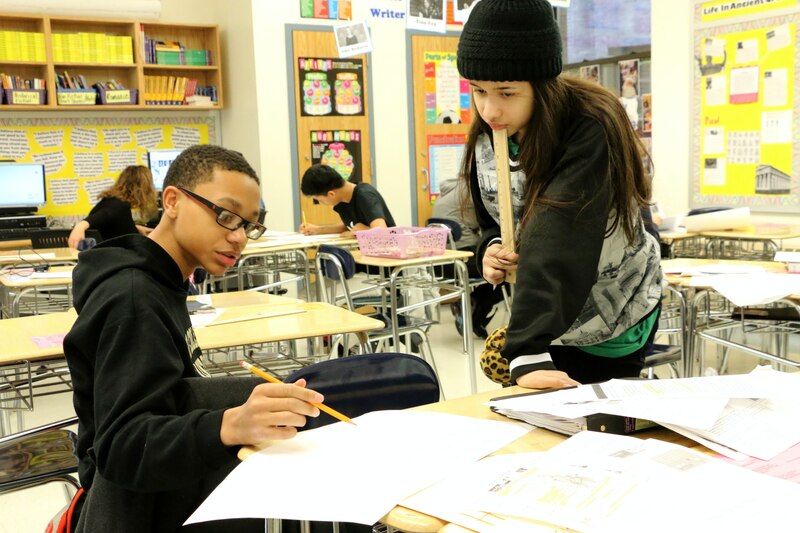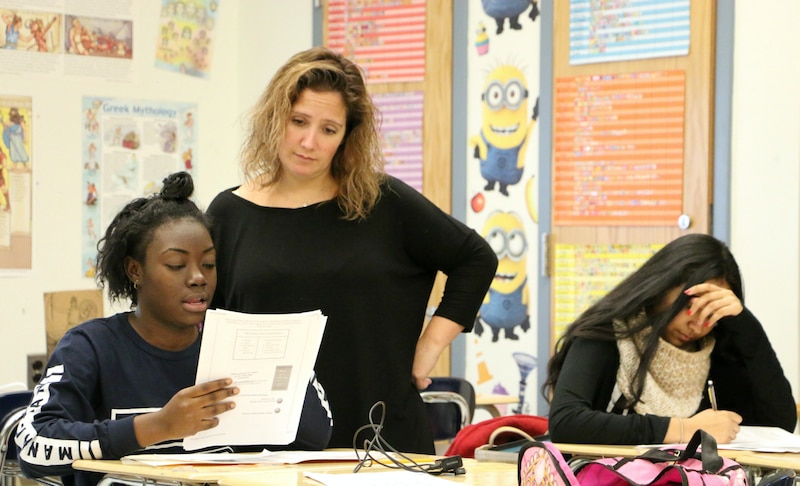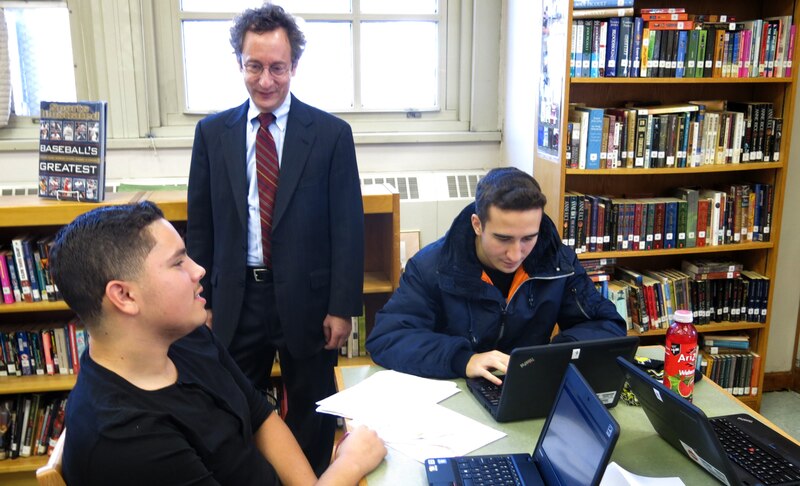
In New York City’s stratified high school system, some schools abound with academic superstars, while others are crowded with students who struggle with basic math and reading.
One group of schools was designed to be different.
Using an admissions model that experts have called a “triumph of educational engineering,” these high schools are set up to enroll students along a neat academic bell curve, reserving spots for applicants at different academic rungs. Many of the schools also feature a career-focused theme like business management or nursing that is meant to entice a range of students to apply.
The approach, which is called educational option, or “ed opt,” dates back to the 1970s, but it has been held up recently as a tool for integrating schools. Last month, the education department said it was expanding the number of ed-opt schools as one step to make its high schools more diverse.
But there’s a problem: At many schools, it’s not working.
Consider the Richard R. Green High School of Teaching, a small school in Lower Manhattan that uses the ed-opt admissions system.
Last year, fewer than a half-dozen of the school’s 151 freshmen had passed the state English tests in eighth grade, according to newly released education department data. And the lack of academic diversity is matched by the school’s racial breakdown: 90 percent of students are black or Hispanic, while just 2 percent are white.
"74% of fully ed-opt schools enrolled virtually no ninth-graders who read on grade level."
“You’ve got a school that’s supposed to be ed opt with that diversity, but isn’t so much,” said Principal Nigel Pugh. “That’s one of the things we’ve been working on a lot.”
His school is not alone.
Of the high schools that use ed opt as their sole admissions system last school year, 32 of 43 enrolled virtually no freshmen who had passed the previous year’s state English test, city data show. (Another 83 high schools use ed opt in combination with other admissions methods.)
And while the model is touted as a tool that can lead to racial diversity, the average fully ed-opt school has a student population that is 86 black and Hispanic and only 6 percent white.
The problem, experts and principals say, is that most of those schools find it impossible to fill their slots for high-performing students. A key reason is that New York City’s high school choice system now features a multitude of selective schools that compete with ed-opt programs for top students — but which don’t have to enroll students at a mix of skill levels.
In that system, sought-after selective schools usually come out on top. Last year, out of nearly 500 traditional high schools, just 81 selective schools enrolled almost two-thirds of the ninth-graders who read on grade level, leaving many ed-opt schools to vie for the rest.
“The problem with ed-opt schools,” said Clara Hemphill, editor of the website, Insideschools, “is that if they can’t attract a range of kids, then they just have low-performers.”
The rise and fall of ed opt
Today, much of ed opt’s luster has been lost to selective schools. But when it emerged in the 1970s and 80s, some of its early adopters were incredibly popular.
Take Murry Bergtraum High School, one of eight original ed-opt schools. In 1985, more than 23,000 students applied for its 850 seats. (By contrast, fewer than 300 students applied for its 150 ed-opt seats in 2014.)
Unlike the neighborhood high schools that most students attended in those years, ed-opt programs were able to draw students from across the city — like magnet programs, which began around the same time. Both were designed partly as a way to draw middle-class families into schools that grown more segregated after white flight to the suburbs. But ed-opt programs came with a twist: They had to enroll students of varying skill levels.
Eventually, the city settled on its current goal that 16 percent of incoming students should be low-performing, 68 percent average, and 16 percent top-performing, as measured by their seventh-grade scores on the state English exams. Academically diverse schools are often mixed by race and class as well, which decades of research have shown to benefit students in the classroom and beyond.
Ed-opt programs became increasingly common until Mayor Michael Bloomberg took office and closed many schools, and their numbers fell. Today, 146 schools use the model for at least part of their admissions, including 20 new programs set to start next fall.
"Six out of every 10 eighth-graders who passed their English tests enrolled in just 81 selective schools last year."
In the past, high-performing students flocked to the most popular ed-opt schools because they had few alternatives. “If it weren’t for the quotas, given the way smart kids are trying to vote with their feet, the city could have several more superschools on its brag list tomorrow,” New York magazine proclaimed in a 1998 article about ed-opt schools.
But, in later years, there was a rise in the number of selective schools that screen all of their students by test scores, middle-school grades, and attendance — and that are free to take only the top performers. The swelling competition added to the recruitment challenges for ed-opt schools whose location or reputation had already made it hard to attract students.
“In a lot of schools, [ed-opt programs] were in name only,” said Peter Goodman, who taught at James Madison High School in Brooklyn from the 1960s through the 90s.
Recruitment for ed-opt schools is “much more difficult now,” he added, “with all the screened options.”

Ed opt vs. screened
Today, most of the fully ed-opt schools fail to draw almost any high-achieving students.
Those students might be unaware of the schools, uninterested in their themes, or unimpressed by their academics. But most of those top students are also jostling for spots at the city’s few “specialized” schools like Bronx Science or the many popular screened schools, which many families consider the surest pathway into elite colleges.
Now, low-performing students are most likely to apply to ed-opt schools, according to a 2013 report by the Research Alliance for New York City Schools. Last year, 83 percent of the incoming freshmen at the fully ed-opt schools did not read on grade level, according to city data, compared to 60 percent of freshmen at schools with screened or test-based admissions.
According to some experts, the only way to boost diversity at ed-opt schools is to reduce the number of screened schools, or convert them into ed-opt.
But, in fact, the reverse has happened.
Former ed-opt schools such as Baruch College Campus High School and Beacon High School shed their bell-curve admissions requirements, and are now among the city’s most competitive screened schools. And of the 20 new ed-opt programs taking applicants next fall, only three are switching away from fully screened admissions.
Carolyn Sattin-Bajaj, an education policy professor at Seton Hall University who has studied the city’s high school admissions system, said that simply applying the model to less popular schools is unlikely to help.
“Just slapping on the ed-opt label to a school that is not particularly in demand,” she said, “will not miraculously achieve diversity.”
In fact, administrators at a few current and prospective ed-opt schools said they doubt they will ever be able to hit their quota for above-average students. Rather than a path to diversity, some view ed opt more as a tool to carefully screen low-performing students.
At ed-opt schools, the city randomly offers admission to half of applicants, while the schools sort through the other half. Though they must admit a portion of students with low test scores, they can select ones who have good attendance records or who are the expected age, a sign they have not been held back.
“My thought is, if I’m going to get the lower-level kids anyway,” an assistant principal at one ed-opt school said, “I’d rather get the kids that I pick.”

Making ed opt work
Of course, under the right conditions, the ed-opt model can lay the groundwork for remarkably diverse schools.
Robert F. Kennedy Community High School, a longtime ed-opt school in Kew Gardens Hills, Queens, is filled with Asian, black, Hispanic and white students, city data shows. It welcomes freshmen who failed their middle-school exams, along with ones who aced them.
Principal Beshir Abdellatif said the school benefits from the diversity of families in the district it pulls from. But he also described an aggressive recruiting practice: He gives PowerPoint presentations to eighth-graders at all the local middle schools, attends their parent association meetings, and even added Mandarin-language courses to appeal to the area’s growing Chinese population.
“It’s tough but it’s worth it,” he said, pointing to the school’s mélange of students. “It’s like a mini-United Nations.”
Deputy Chancellor Phil Weinberg, who was the longtime principal of the High School for Telecommunication Arts and Technology, a diverse ed-opt school in Brooklyn, said the burden is on ed-opt schools to foster that diversity through “smart outreach” to families from different backgrounds. He suggested that the city would not alter the choice system — for example, by reducing the number of screened schools — simply to help ed-opt schools recruit more top students.
Families make choices “about where they might want to be,” he said. “Correcting for that isn’t something that we would do.”
That leaves diversity looking like a distant dream for some schools.
Evan Schwartz, principal of Alfred E. Smith High School in the South Bronx, said the city is allowing his school to launch an ed-opt program this fall because it has been able to drum up demand: Last year, five students applied for every open seat. And yet, he still doubts that the school will be able to attract the top-scoring students it would need to become academically diverse.
“I don’t know if, in the end,” he said about becoming ed opt, “it’s going to help us that much.”
Stephanie Snyder contributed reporting.
